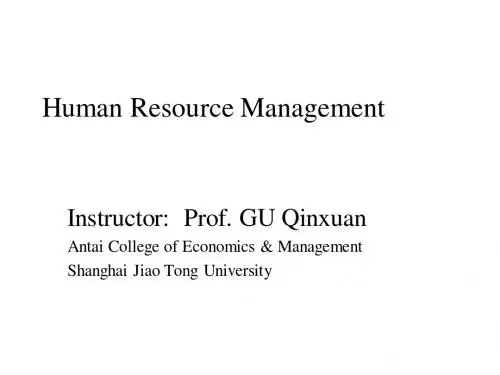人力资源管理第八章 compensation managem
- 格式:ppt
- 大小:6.88 MB
- 文档页数:124
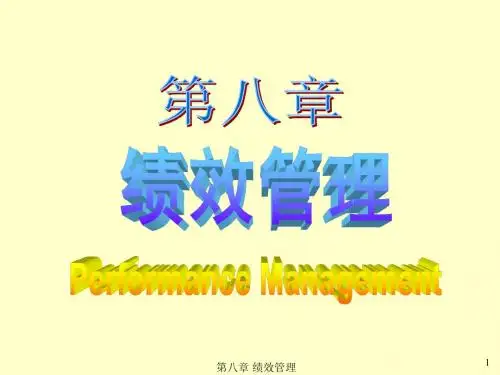
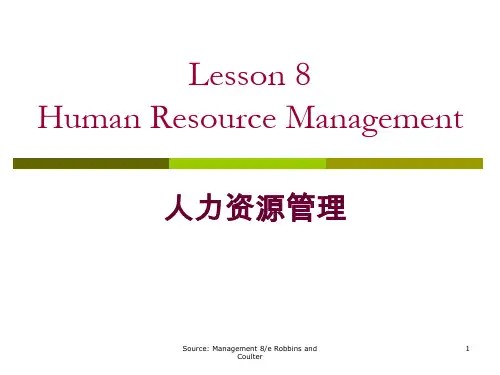
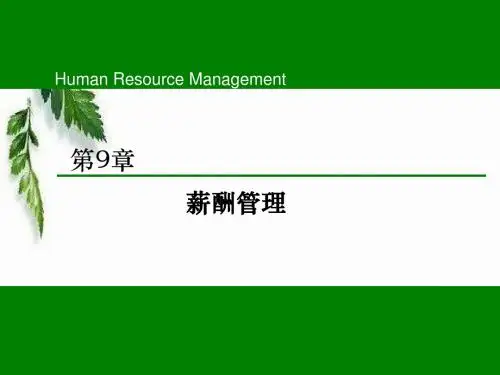
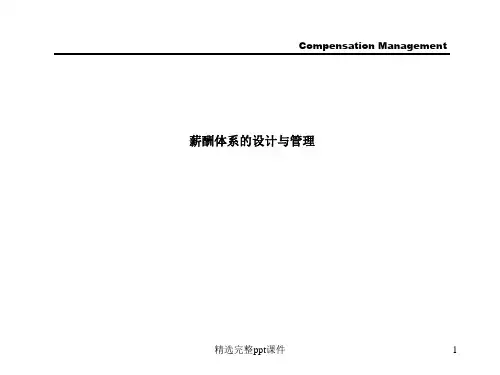
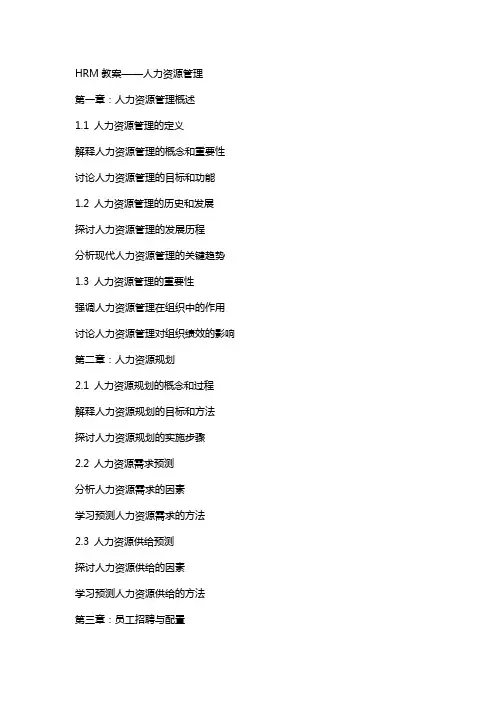
HRM教案——人力资源管理第一章:人力资源管理概述1.1 人力资源管理的定义解释人力资源管理的概念和重要性讨论人力资源管理的目标和功能1.2 人力资源管理的历史和发展探讨人力资源管理的发展历程分析现代人力资源管理的关键趋势1.3 人力资源管理的重要性强调人力资源管理在组织中的作用讨论人力资源管理对组织绩效的影响第二章:人力资源规划2.1 人力资源规划的概念和过程解释人力资源规划的目标和方法探讨人力资源规划的实施步骤2.2 人力资源需求预测分析人力资源需求的因素学习预测人力资源需求的方法2.3 人力资源供给预测探讨人力资源供给的因素学习预测人力资源供给的方法第三章:员工招聘与配置3.1 招聘的概念和过程解释招聘的目标和方法探讨招聘的实施步骤3.2 招聘策略和渠道分析招聘策略的选择学习利用不同渠道进行招聘3.3 员工配置与安置探讨员工配置的原则和方法学习员工配置的实施步骤第四章:员工培训与发展4.1 员工培训的概念和目标解释员工培训的重要性探讨员工培训的目标和内容4.2 培训策略和计划分析培训策略的选择学习制定培训计划的方法4.3 培训的实施与评估探讨培训的实施步骤学习培训效果的评估方法第五章:员工绩效管理5.1 绩效管理的概念和目标解释绩效管理的重要性探讨绩效管理的目标和功能5.2 绩效考核方法和指标分析绩效考核的方法和指标学习制定绩效考核体系的方法5.3 绩效管理的过程与实施探讨绩效管理的过程和步骤学习绩效管理的实施技巧第六章:员工薪酬管理6.1 薪酬管理的基本概念解释薪酬管理的目标和重要性探讨薪酬管理的组成部分6.2 薪酬体系的设计分析薪酬体系设计的原则和步骤学习薪酬结构设计的方法6.3 薪酬激励与福利计划探讨薪酬激励的概念和类型学习福利计划的设计与管理第七章:员工关系管理7.1 员工关系管理概述解释员工关系管理的目标和重要性探讨员工关系管理的挑战和机遇7.2 员工沟通与协作分析有效的员工沟通策略学习团队协作的促进方法7.3 员工冲突与管理探讨员工冲突的原因和类型学习解决员工冲突的技巧和方法第八章:人力资源法律遵从性8.1 人力资源法律遵从性的概念解释人力资源法律遵从性的重要性探讨人力资源法律遵从性的范围8.2 劳动法的基本原则分析劳动法的基本原则和条款学习劳动法的合规管理方法8.3 人力资源法律风险防范探讨人力资源法律风险的识别和评估学习法律风险防范和应对策略第九章:人力资源信息系统(HRIS)9.1 人力资源信息系统的基本概念解释人力资源信息系统的目标和功能探讨人力资源信息系统的发展趋势9.2 HRIS的实施与运营分析HRIS实施的关键成功因素学习HRIS的运营管理和维护9.3 HRIS的战略应用探讨HRIS在人力资源管理中的战略应用学习利用HRIS提升人力资源管理效率第十章:人力资源管理的未来趋势10.1 人力资源管理的新兴趋势解释新兴趋势对人力资源管理的影响探讨人力资源管理的创新实践10.2 人力资源管理的数字化变革分析数字化对人力资源管理的影响学习利用数字化工具提升人力资源管理效能10.3 人力资源管理的可持续发展探讨人力资源管理在可持续发展中的作用学习制定可持续发展的人力资源策略重点和难点解析重点环节1:人力资源管理的定义和目标补充说明:人力资源管理是对组织内外部人力资源的获取、开发、激励和维护等方面进行有效管理的过程。
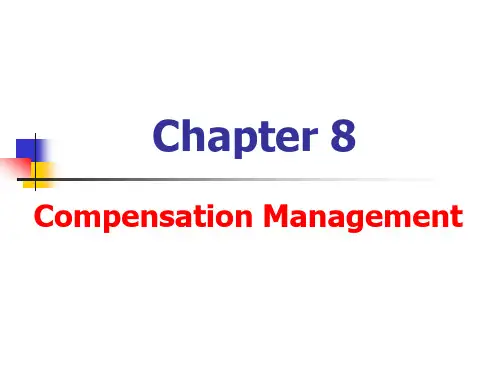

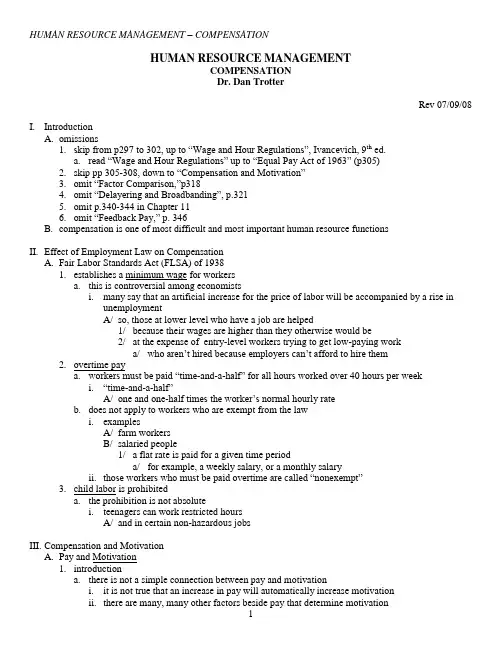
HUMAN RESOURCE MANAGEMENTCOMPENSATIONDr. Dan TrotterRev 07/09/08 I. IntroductionA.omissions1. skip from p297 to 302, up to “Wage and Hour Regulations”, Ivancevich, 9th ed.a.read “Wage and Hour Regulations” up to “Equal Pay Act of 1963” (p305)2. skip pp 305-308, down to “Compensation and Motivation”3. omit “Factor Comparison,”p3184.omit “Delayering and Broadbanding”, p.3215.omit p.340-344 in Chapter 116.omit “Feedback Pay,” p. 346pensation is one of most difficult and most important human resource functionsII. Effect of Employment Law on CompensationA.Fair Labor Standards Act (FLSA) of 19381. establishes a minimum wage for workersa.this is controversial among economistsi. many say that an artificial increase for the price of labor will be accompanied by a rise inunemploymentA/ so, those at lower level who have a job are helped1/ because their wages are higher than they otherwise would be2/ at the expense of entry-level workers trying to get low-paying worka/ who aren’t hired because employers can’t afford to hire them2. overtime paya.workers must be paid “time-and-a-half” for all hours worked over 40 hours per weeki.“time-and-a-half”A/ one and one-half times the worker’s normal hourly rateb.does not apply to workers who are exempt from the lawi.examplesA/ farm workersB/ salaried people1/ a flat rate is paid for a given time perioda/ for example, a weekly salary, or a monthly salaryii. those workers who must be paid overtime are called “nonexempt”3. child labor is prohibiteda.the prohibition is not absolutei. teenagers can work restricted hoursA/ and in certain non-hazardous jobsIII. Compensation and MotivationA. Pay and Motivation1. introductiona.there is not a simple connection between pay and motivationi. it is not true that an increase in pay will automatically increase motivationii. there are many, many other factors beside pay that determine motivation2. famous theories of motivationa.needs theoriesi. Maslow’s theory is the most famousA/ Maslow said needs have to be fulfilled in a hierarchy1/ in order for the employee to be motivated2/ basic needs must be satisfied firsta/ once these are satisfied, increasing compensation will NOT motivateb/ notice that at the top of the pyramid, compensation doesn’t motivate at alli/ but at the bottom, it motivates a lot3/ Maslow’s needs hierarchy (starting at the bottom and moving up)a/ physiological needsi/ examplesA) foodB) waterb/ safety needsi/ exampleA) no fear of plant machinery harming one as he worksc/ social needsi/ exampleA/ company parties and picnics make employee happyd/ esteem needsi/ exampleA/ worker gets recognized with awards for superior worke/ the need for self-actualizationi/ doing what one would do if he didn’t have to worry about getting paidb.social comparison theoriesi. states that employee is motivated by how FAIR the employee thinks the pay system isA/ the key factor is not IS the pay system fair1/ rather, does the employee PERCEIVE the system as being fairc.expectancy theoryi. motivation depends on expectation that effort will produce performanceA/ and further, that performance will produce rewardd.behavior modificationi. things emphasizedA/ rewardsB/ punishmentsii. some behavior modification experts believe that an ordinary person can be made a concert pianistsB.Pay and SatisfactionA/ Herzberg’s Two-Factor Theory1/ main pointa/ satisfaction does not motivatei/ but dissatisfication WILL demotivate2. rewards have two categoriesa.satisfiersi/ a/k/a “hygiene factors”ii/ examplesA/ payB/ working conditionsiii/ adequate pay will not motivateA/ but inadequate pay WILL demotivateb.motivatorsi/ often called “high-level m otivators”ii/ examplesA/ achievementB/ recognitionC/ responsibilityD/ advancementE/ the work itselfiii/ notice how some of these can be given to the worker for very little costA/ example1/ a name on a billboard proclaiming: “Employee of the Month”C.Pay and Productivity1. the link between pay and productivity is not cleara.just like the link between pay and motivation is not cleari.not that there is probably a link between motivation and productivityA/ more motivation, more productivityb.historical theoriesi.“hungry man theory”A/ wages should keep worker on the edge of starvation!!!1/ so worker would be motivated to work to stay alivea/ and, the more he worked, the more productive he wasii. “economic man theory” (Adam Smith, 1776)A/ wages should be as high as possible1/ the more the worker is paid, the more motivated he’ll bea/ and the more motivated, the more productive he’ll beb/ note how this contradicts Herzberg’s Two Factor theoryi/ more money won’t motivateA) will only stop dissatisfactionIV. Compensation DecisionsA. Three basic decisions1. The Pay-Level Decisiona.definitioni. pay is set relative to wokers working on SIMILAR jobs in OTHER organizationsb.three different pay-level strategies may be takeni. listedA/ high-pay strategy1/ advantagea/ the best workers are obtainedi/ low turnoverii/ high productivity (hopefully)2/ disadvantagea/ expensivei/ company may not able to compete in its marketsB/ low-pay strategy1/ used only when there’s no other optiona/ company doesn’t have the money to pay at least average wagesC/ comparable-pay strategyii. factors determining choice of strategyA/ tight/loose labor market1/ if there aren’t enou gh workers to hire, company will have to adopt a high-pay strategy B/ profit margins1/ firm can’t pay so much that it will lose moneyC/ how ethical or kind the manager is1/ the kinder, the higher the wages likely to beA/ of course, this could backfire if the company goes broke because paying too muchc.pay surveysed by companies to see what wages are like in OTHER companiesii. factors which may pay surveys effectiveA/ at least 30 percent of jobs are comparedB/ the jobs which most workers hold should be surveyedC/ similar jobs IN DIFFERENT INDUSTRIES should be used1/ because a potential worker might well be attracted to go work in a different industry a/ so, what other industries are paying is relevantiii. methodA/ most often used is mailed questionnaire1/ followed up w/ a phone call2/ cheapa/ but hard to get a lot of data from busy HRM personnel in the other company2. The Pay Structure Decisiona. definitioni.the relative pay for employees with DIFFERENT jobs within the SAME organizationb. job evaluationi.the relative worth of every job in the organization is determinedA/ involves much subjective judgment1/ so, objective measures (“factors”) are used to measure worth of the joba/ examples of job factorsi/ skills requiredii/ much responsibility?iii/ effort requirediv/ working conditionsv/ safe or dangerous work siteii. ask class to do a job evaluation for these jobs…A/ sewer cleanerB/ a person who cleans nuclear fuel rods out of a reactorC/ lawyeriii. three methods to do job evaluationA/ ranking1/ problem: no assurance that there are equal intervals between the ranksa/ examplei/ could be a huge difference between #1 and #2A) but small difference between ##2-10B) this means #1 will get only a little bit more pay than #2B/ classification1/ classes of jobs are createda/ a description of the requirements for each job is listed next to the classi/ cf. Exh 10-7, p3182/ advantagesa/ easy to constructb/ easy to understandc/ easy to communicate to employees3/ disadvantagea/ if not enough classifications, some jobs won’t fiti/ exampleA/ Exh 10-7, p. 318, Ivancevich, 9th ed1/ what if the job required “complex computer work, no managerialresponsibility, no team leadership?”C/ point system1/ how its createda/ see Exh 10-8, p319b/ each factor is given a range of pointsc/ each factor is weightedd/ each factor’s assigned points are multiplied by that factor’s weighte/ the points for all the factors are summedi/ the total points are used to rank other jobs which are scored the same way 2/ the most popular method to do job evaluation3/ advantages and disadvantagesa/ advantagesi/ easy to useii/ easy to understandiii/ easy to understand to employeesb/ disadvantagei/ takes much time to develop3. The Individual Pay Decision (Chapter 11, Ivancevich, 9th ed)a. fundamental questioni.should the company pay employees the same if they are doing the same job?A/ i.e., if several employees are in the same pay classification, should they be paid the same?B/ most companies, in fact, discriminate between employees at the same pay grade1/ what is this discrimination based on?a/ individual differencesi/ experienceii/ skillsiii/ performanceb/ seniority2/ ask: should a person with more seniority but less skills be paid more?V. Methods of PaymentA. total compensation consists of three elements1. Summarya. base payb. variable payc. indirect payi.also known as “benefits”ii.examplesA/ health insuranceB/ unemployment insuranceC/ retirement accountsiii.extremely importantA/ see Chapter 12, Ivancevich, 9th ed1/ we won’t cover this in class1. Base Paya. a flat rate is paid for a period of time workedi.flat ratesA/ all workers in the same category are paid the same amount1/ regardless of differences in skills and senioritya/ examplei/ all “Clerk II’s” are paid 8:00 per hourii.the period of time workedA/ determines two basic types of base pay1/ wagesa/ flat rate is paid per houri/ workes being paid wages are subject to overtime law (FLSA) 2/ salarya/ the period of time is something other than an houri/ for exampleA/ weekly salaryB/ monthly salaryb/ salaried workers are not subject to the overtime law2. Variable Paya. introductioni.variable pay is mainly used for incentivesA/ to get above-average performanceA companies are using more and moreA/ can’t compete in a global e conomy without higher performance1/ and variable pay generally gives higher performanceb. general descriptioni.the worker gives up a guaranteed level of incomeA/ in return for an income that might be higher1/ however, the level of income might also be lowera/ so, variable pay has more risk and more rewardc. three basic types of variable payi. individual incentivesA/ examples1/ merit paya/ base pay from previous period adjusted upwardsi/ based on performance appraisalsii/ using some kind of a reward formulaA) see Exh 11-2, p. 335, Ivancevich, 9th edb/ between 80 to 90 percent of all USA private firms usec/ effectiveness of merit payi/ little research has been doneA) so, no one knows how effective merit pay isd/ argument in favor of merit payi/ its linked directly to the appraisal systemA) which (supposedly) rewards the highest performers1) which should be highly motivatinge/ arguments against merit payi/ employees don’t see the connection between pay and performanceA) reasons why1) because appraisal systems are very flaweda) they don’t reward the high performers2) because the merit increases are often secretii/ competence and incompetence is not equally spread through the work group being evaluatedA) if everyone in the group is “outstanding”1) cf. Exh 11-2, p335a) everyone would get a 12-15% pay raisei) there’s no discrimination between good and poor performersA] so, there’s no incentive that merit pay is supposed to bring iii/ never been proven that merit pay increases performance2/ straight pieceworka/ descriptioni/ pay fluctuates based on units of production per time period b/ examplei/ one dollar per dressA) so, if the workers sews 25 dresses in one hour, she makes 25.00c/ advantagei/ worker sees direct link between performance and rewardA) some workers are highly motivated this wayd/ disadvantagesi/ its very hard to set the amount per itemA) if set too low1/ extremely demotivatingB) if set too high1/ extremely expensiveii/ it will not work if it takes a team of workers to make the productA) the lower performing workers will hold back the high-performerB) example1) workers on an assembly line: A-B-C-D-Ea) “C” can’t work fast to make more moneyi) he doesn’t have enough intermediate products from B3/ differential piece ratea/ a/k/a the “Taylor plan”b/ how it worksi/ two different piece rates are paidA) one for below average workers1) and a different rate for above average workersc/ purpose is to reward and motivate superior workers4/ standard hour plana/ the average amount of time to do a task is calculatedi/ using data from the industry the job is inii/ a standard level of pay is assigned for this timeA) this amount is paid to the worker1) no matter how long it takes the worker to do the jobb/ examplei/ standard hours for auto mechanic to fix brakes is two hoursA) auto mechanic’s labor is worth 50.00 per hourB) mechanic is paid 100.00 to replace the brakes1) even if he fixes the brakes in 1 ½ hoursc/ the incentive is to save timei/ instead of moneyA) the same amount of money is going to be made regardless of how muchtime is taken5/ production bonus systema/ pay consists of two partsi/ an hourly rateii/ a bonus payment if production exceeds a certain standard6/ commissionsa/ definition of “commission”i/ a percentage of salesb/ examplei/ real estate agentA) usually makes about 6 percent of the price of the housec/ requirements to make commissions worki/ the worker must work independentlyA) example1) if a professor were paid a certain amount per studenta) the professor has no control over how many students he hasii/ performance must be easily measured in order to calculate commissionA) example1) a clerk working at a “complaint desk”a) hard to measure her performanceiii/ commission must not motivate worker to do unacceptable thingsA) examples1) professor paid a percentage of the tuition that graduating students paya) professor has incentive to graduate everyonei) even those students who have failedii.group incentives (“team incentives”)A/ how it works1/ the individual incentives listed above are given to work-teamsa/ and NOT to the individuals on the work teami/ then, the team divides up the dollars earned by the teamB/ advantages1/ causes team to work together instead of against each othera/ examplei/ one team member wants to work very hard to make incentive payA/ because he’s poor, has financial needsB/ the other team members have plenty of money, want to relaxC/ the hard-working team member will be held back by the lazy members 1/ they won’t cooperate to allow the hard-worker to produce a lot ii/ analogyA/ if one crab tries to crawl out of a bucket of crabs1/ all the other crabs pull him back into the bucketiii. organization-wide incentivesA/ three main types1/ suggestion systemsa/ very popular method all over the worldb/ how they worki/ a formal system is set up to get employee suggestionsA) usually the suggestions are about ways to improve production1) eliminate waste, save time, etc.ii/ if the suggestion worksA) the employee who suggested the idea is rewarded1) moneya) often a percentage of the money saved for the organization2) recognitiona) name put on a bulletin board or a sign, etc.2/ gainsharinga/ what is shared with all the workers of the organizationi/ savings in costsA) different than profit-sharing plans1) those plans share profitsB) how savings in costs might be measured1) hours worked2) dollars spent on labor3) dollars spent on wasteb/ spot gainsharingi/ gainsharing is used on a particular problem that needs fixingA) and then is cancelled1) examplea) too much rework on a production line3/ profit-sharinga/ what is shared with all the workers of the organizationi/ profitsA) as opposed to savings in costsb/ methods of sharing profitsi/ cash paymentsii/ Employee Stock Option Plans (ESOPs)A) company stock is paid to the employee instead of cashB) these are extremely popularC) advantage1) employee has ownership in the companya) makes him more loyalb) gives him more incentive to work harderD) word of advice to employees who receive stock this way1) the worker-stockholder is very UNDIVERSIFIEDa) all his eggs are in the company basketi) if the company goes bankrupt, the stock is worth zero VI. People-Based PayA. examples1. skill-based paya. pay set based on what skills the employee has masteredi.if the worker’s job is expanded to require a new skill…A/ example1/ a new machine is installed on the assembly lineB/ the worker is paid a certain amount more for mastering the new skillb. extra pay for skills usually replaces annual raisesi.advantage to the employerA/ he spends the same amount1/ but he knows the value of his workforce is increasingc. usually used in high-volume situations where the work is routinei. because it’s easy to identify what skills are needed2. knowledge-based paya. extra pay given for knowledge the worker hasi.examplesA/ computer programmer learns a new programming language3. credential-based paya. extra pay given for earning a professional credentialb. examplei.legal secretary passes the bar examA/ she’s now paid as a lawyer, not as a secretary4. competency-based paya. extra pay is given for…i.skills, ANDii.knowledge, ANDiii.credentials, ANDiv.characteristics of the workerA/ examples1/ values2/ motives3/ personality traits4/ self-imageb. disadvantagei.very subjective to measure characteristics of the workerii.hard to tie characteristics of the worker to performanceA/ example1/ some nasty people might be good workersVII. Issues in Compensation AdministrationA Executive Pay1. controversiesa. lately executive pay has been extremely high compared to other workers in corporations (USA)i.this only true for the largest of USA corporationsb. severance packagesi.definitionA/ what is given to departing executives after they are fired, or retireii.problemA/ they are often so generous, it is the executives best interest to fail!1/ and move on to another corporation to get another severance packageB. Pay Secrecy or Openness1. the “secret system”a. the amount of pay is considered privileged informationi.only people who may knowA) the employeeB) the supervisorC) human resource departmentb. in extreme cases, employees told they ca n’t even discuss their pay with anyonec. advantagei.allows the employer to make different deals with employees working the same jobA) example1)school principle hiring housewives to teacha) some housewives have wealthy husbandsi) not concerned about payA] rather, want to be at the school were their child isB] so, school can pay them low1] and make the deal more attractive by giving free tuitiona] if free tuition not secret, other workers may feel angryi] those that don’t have children can’t get the same deal ii.disadvantageA) if the compensation system in unfair1)the inequities will become knowna) if the system is not secretC. Pay Security1. introductiona. this highly motivates many workersb. there is a price to pay by the worker to get pay securityi.pay is lowerA/ example1/ employee makes sure he’s not the highest paid person in the departmenta/ in a downturn, he won’t get laid offii.job might be less satisfyingA/ worker less willing to move around to find a more fulfilling job2. methods company use to provide pay securitya. guaranteed annual wagei.typically, how it worksA/ after the employee passes a probationary period1/ company guarantees him employment for a certain period at a certain wage ual ly, company has an “emergency clause”A/ if the company facing a financial emergency, it doesn’t have to honor its commitmentb. supplementary unemployment benefitsi.the company contributes to a fundA/ if the worker is laid off, the fund pays cash periodically to the worker1/ these payments supplement the government’s unemployment benefitsc. cost-of-living adjustments (COLAs)i.definitionA/ wage increases or decreases pegged to the rise or fall of the general price level 1/ i.e., when inflation increases, wages increase the same amountii.COLAs are not motivatingA/ employees have come to expect them1/ they are not supposed to be pay raisesa/ merely supposed to keep the worker even to his last salaryd.severance payi. a one-time paymentA/ distinguish supplementary unemployment benefits1/ paid periodicallyii.typical provisionA/ one week’s pay for each year of serviceD.Pay Compression1. definitiona.not enough discrimination between senior employees and new employeesi. or, between supervisors and subordinates2. how it happensa. long-time employees don’t get enough pay raisespany has to pay market rates to get new employeesA/ so new employees get paid a lot。


